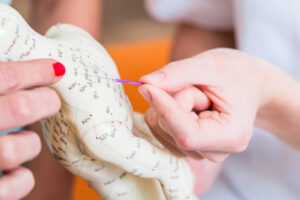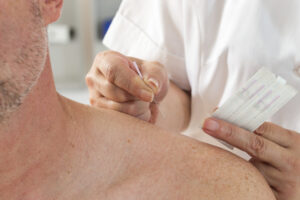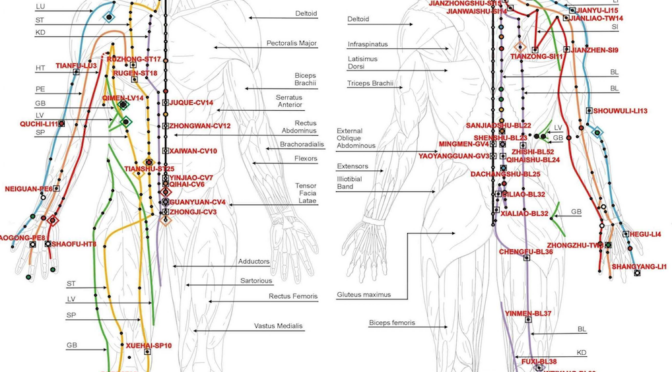Commonly accepted notions of western medicine note a number of systems in the body that transport a substance from one area of the body to another.
Be this the transportation of oxygen through the body’s circulatory system, or the transportation of food through the digestive system, scientists have largely focussed on those systems that have an immediate physical presence.
However, some eastern cultures have been aware of a completely separate bodily system for over 8,000 years and have used it as their basis for understanding human biology, as well as to treat illnesses, oftentimes noticing these way before they manifest themselves in symptoms that western medicine would recognise. This system is known as the meridian system.
Only now is this ancient understanding of the body starting to gather medical research and recognition by modern scientists.
What Are Meridians?

Essentially, meridians are a network of channels through the body through which energy, or life force (known in traditional Chinese medicine as Qi) is transported. They can be thought of as an ‘energy highway’ bringing life to all of our essential organs and our extremities.
In the traditional Chinese approach, there are 12 paired meridians and two single mid-meridians. These are split into the Yin and the Yang, each balancing the other. While Yin meridians flow up the body, Yang meridians flow down and each of these is more active at certain times of the day. Their balance is essential, and practices such as yoga and meditation have long been held up as ways of restoring and maintaining that balance.
When one of these channels becomes blocked, the energy being transported through it is stopped. The energy begins to grow stagnant and the areas of the body that are supposed to be receiving energy, feeding from it and gathering strength, simply don’t get it. This leads to issues in our health. In order to unblock the channel, we turn to practices such as acupuncture.
Acupuncture
Acupuncture works by inserting thin needles into specific points on the body, where the meridians reach the surface, through the skin. The points at which the needles are inserted are very specific and have not changed in millennia – archaeologists uncovered a well-preserved frozen body from around 3,300 BC which had tattoo markings on his body at the various acupuncture points, or ‘acupoints’.
By using needles to tap into each of these meridian points, the energy flow is stimulated once more, blockages are removed and with a restored energy flow, wellness is felt in the body once more.
Scientific Evidence of Meridians
 Researchers at Seoul National University have revealed astonishing evidence of a new circulatory system that corresponds precisely with the meridian channels described by traditional Chinese medicine.
Researchers at Seoul National University have revealed astonishing evidence of a new circulatory system that corresponds precisely with the meridian channels described by traditional Chinese medicine.
They revisited a study from the early 1960s which reported evidence for a circulatory system which lay outside of the circulatory, nervous, and lymphatic systems. Dr. Bonghan Kim called this the “primo-vascular system” (or PVS).
The modern revisit to the study had the advantage of modern technologies at its disposal, which made the PVS much easier to see. The system was found to be physically present as minuscule ‘threads’ which scientists found throughout different organs, as well as in thoracic ducts and tissues. They did this by injecting specific dyes at the acupoints, revealing the threads when viewed using an electron microscope under specific lights. No such threads were found at non-acupoints.
Further Studies
In addition to this groundbreaking study, various others have taken place which brought additional evidence of the presence of a meridian system. One 2013 study scanned various acupoints in the human body using three-dimensional CT scans and revealed that acupoints have a much higher density of microvessels as well as complex microvascular structures. These anatomical structures were not found at non-acupoints.
In addition to this, a separate study conducted in Japan found that acupuncture points on the skin tended to have a temperature of 0.1 – 0.6 degrees Celsius higher than the surrounding areas, suggesting a higher concentration of energy beneath the skin at those locations.
The Future For Medicine?
This scientific confirmation of a system that has existed in the body all this time, but had been overlooked, could be the start of a new approach to medicine and the way certain illnesses are treated.
Though the research is still quite new, it is making ripples in the medical world, and like the acupuncturist’s needle, could be the stimulation that was needed all along to unblock the western understanding of the human body and the subsequent medical approaches it will take in the near future.
Sources:
http://upliftconnect.com/science-proves-meridians-exist/
http://rheumatology.oxfordjournals.org/content/43/5/662.full
http://www.realnatural.org/new-circulatory-system-evidence-for-acupuncture-meridians/
http://www.ncbi.nlm.nih.gov/pubmed/20633480/
http://www.jinshindo.org/meridians
http://www.jams-kpi.com/article/S2005-2901(13)00208-2/fulltext
http://www.ncbi.nlm.nih.gov/pmc/articles/PMC3793287/
http://www.buddhistdoor.net/news/korean-researchers-claim-scientific-evidence-of-meridians

